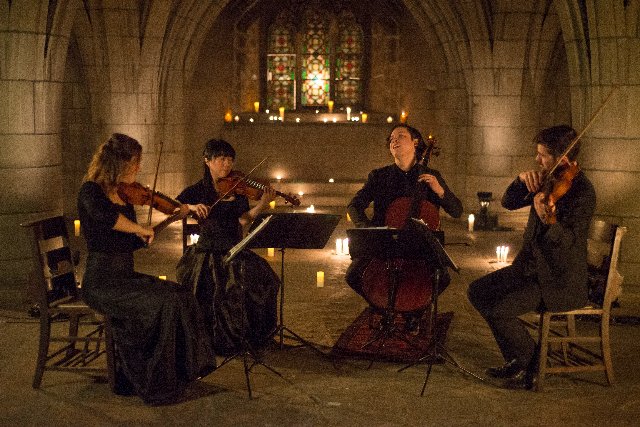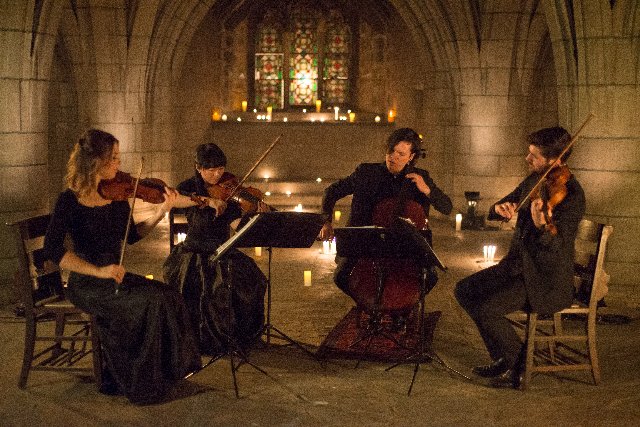The Attacca Quartet Celebrates Life at Crypt
With Beethoven's Hymn of Thanksgiving, Time Stands Still
By: Susan Hall - Feb 01, 2018
The Attacca Quartet
Beethoven's Opus 132
The Crypt Sessions
Unison Media
Church of the Intercession
New York, New York
February 1, 2018
Photo Credit Tristan Cook
In the spring of 1825 Ludwig von Beethoven was very sick with liver disease and stomach inflammation. He wrote his doctor asking for help. His doctor wrote back: "No wine, no coffee, no spices." He recommended recuperating in the country for fresh air and natural milk.
Beethoven went to the country and cured himself with musical notes. He could only hear them in his own head, because he was deaf by now. This olympian Quartet contains a "holy song by a convalescent to the divinity in the Lydian mode."
The elegance and lifefulness of the first movement contrast sharply with the hymn, which is written from a place at which we arrive after recovering from a serious illness. Everything about life seems miraculous again. The memory of illness is still very present although it contrasts with feeling well again.
This quartet is an autobiographical prayer of thanks. With this music, Beethoven is expressing joy and appreciation for the gift of life. The Attacca Quartet join him in celebration.
The pace of the hymns is glacially slow and yet it is not excruciating, perhaps because each hymn is exactly sixteen beats. Each prelude is half the size at eight beats. There is no tension in the Lydian mode. Notes have only two values. Swept up in the beauty of the hymn’s melody, we are not in a musical mode which produces conflict or anxiety.
Instead Attacca suspends us in another world, outside time. Although the term attacca in music is about taking a pause, what was striking about this performance of Opus 132 was the actual attacks at the beginning of phrases, which gave shape to lines that are sometimes played to join one with the next.
The repeating arches of the Crypt seem to accentuate the hymn's repeating phrases. which are reduced to only two notes as we hear it over and over. With the composer, the Quartet examines each part of the hymn in wonderment. The illusion of time standing still is created.
Variations begin as we return to the slow parts, but some rhythmic activity is indicated and dissonance added. As the subject is reduced to five notes and becomes a fugue, the viola and second violin get their chance to shine. Overlapping of the hymn phrase is particularly juicy as the Quartet members look to each other for textural contrast. They bring forward the reduction of the hymn to two notes.
The hymn hovers in the Crypt, hidden behind these agonizingly slow notes. Can only a creator looking down see this work in its entirety? We are in tight focus as the artists invite us to contemplate up close what is about us. We are in the moment of each note, and then move on to the next.
The first accidental crashes out of this suspension and moves us into a feeling of well-being. An amazing contrast, exuberantly delivered by the Quartet in trills, harmony, and syncopation, all tools of the Romantic period. Having submitted to the slowness, the Quartet takes up the contrast with vigor and joy. They bring to the surface what old music had hidden and do it with a bold, distinct sound.
Has time stood still so that we absorb everything around us, in the otherwise silent, darkened Crypt? Can we hear only the beat of our own hearts? Can it be that Beethoven’s forced retreat into the notes in his head creates notes now harbored in ours, turning us inside too?
The Crypt Sessions ask very deep questions in their musical selections. If they do not always suggest answers, new questions emerge and enrich. These performances are understandably sold out in minutes. With wine and food served at the start, they are among the most invigorating and moving moments in music. In this Attacca performance we are in the present of the musicians, the composer and The Crypt. Right here and now.




